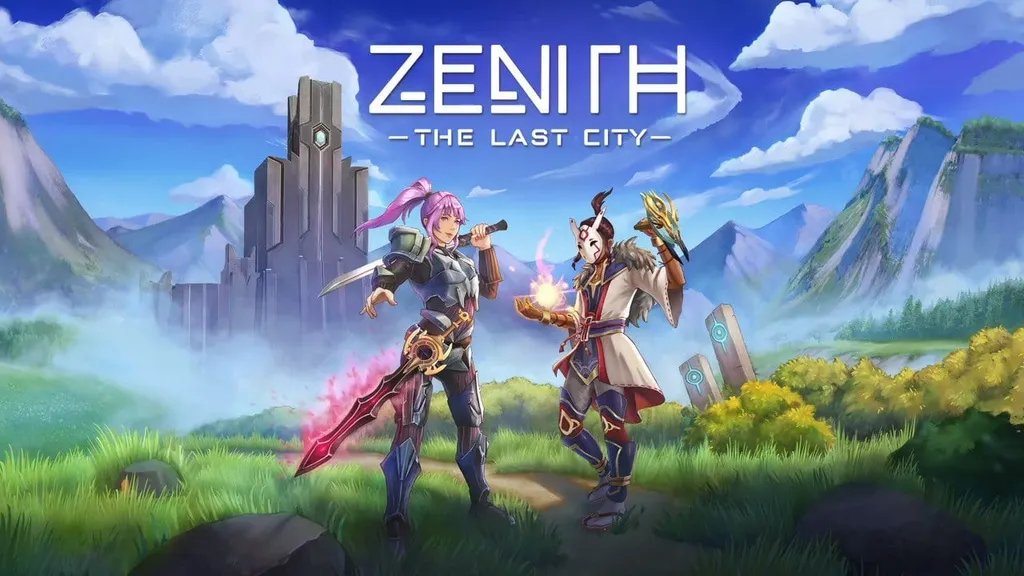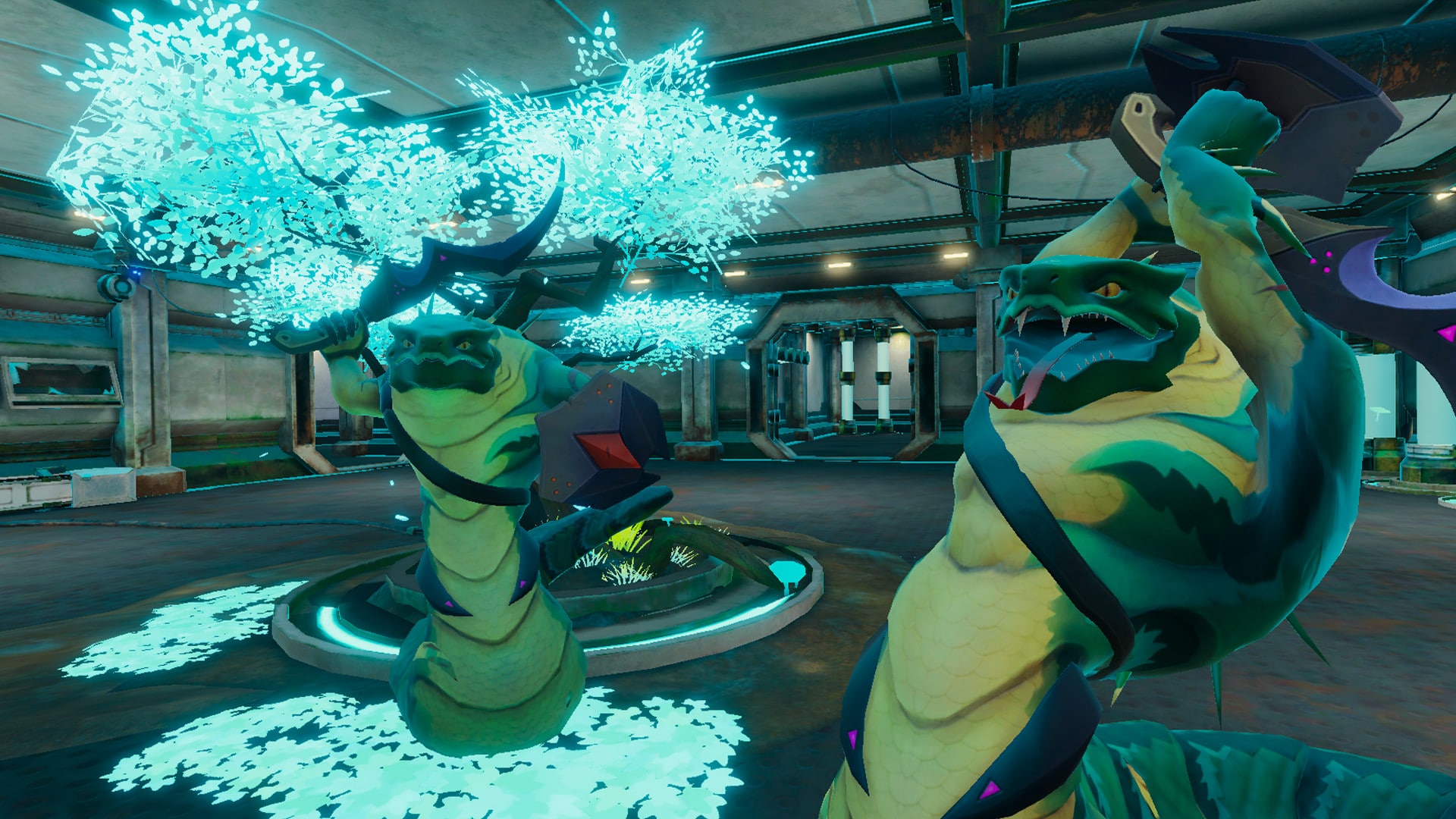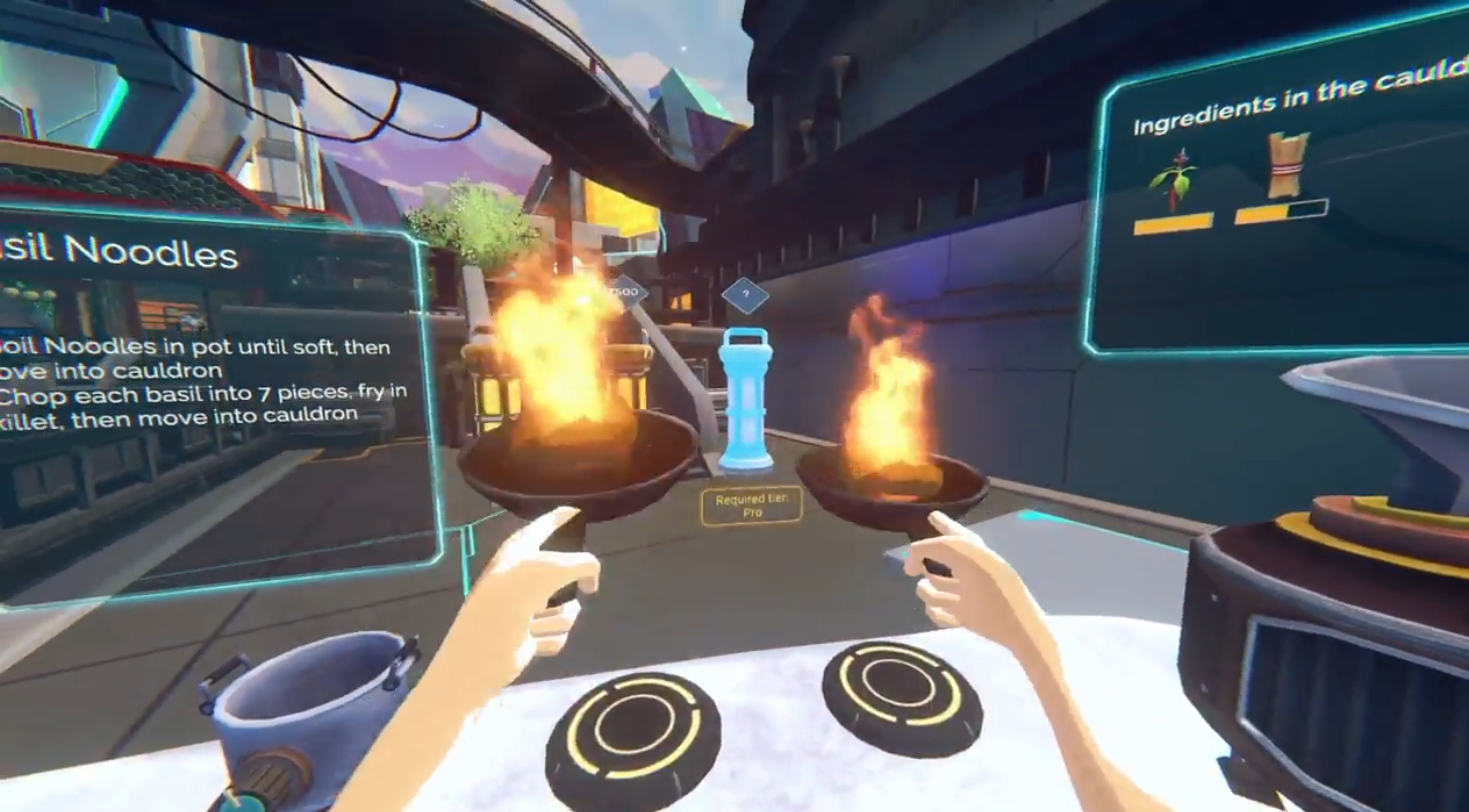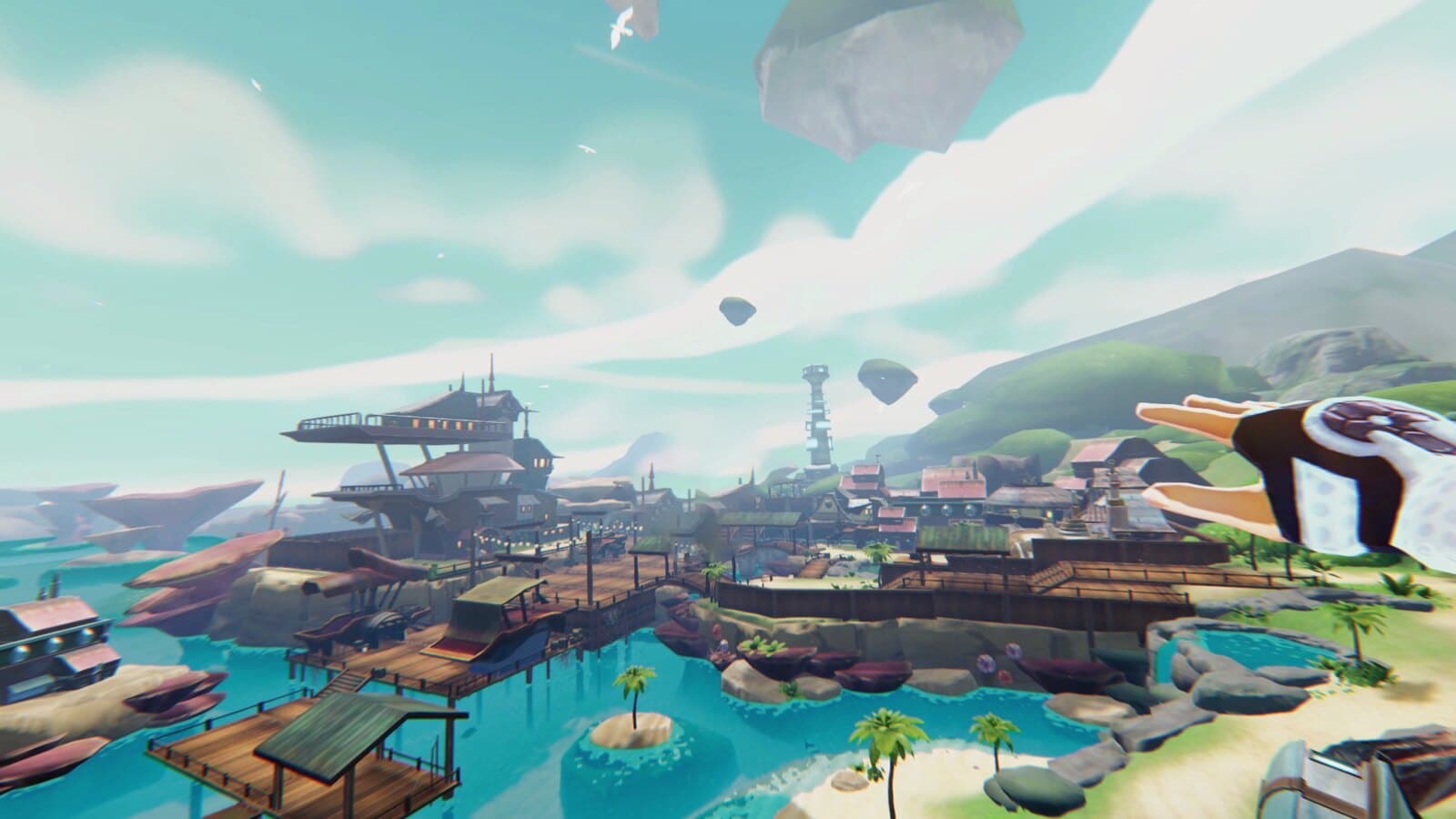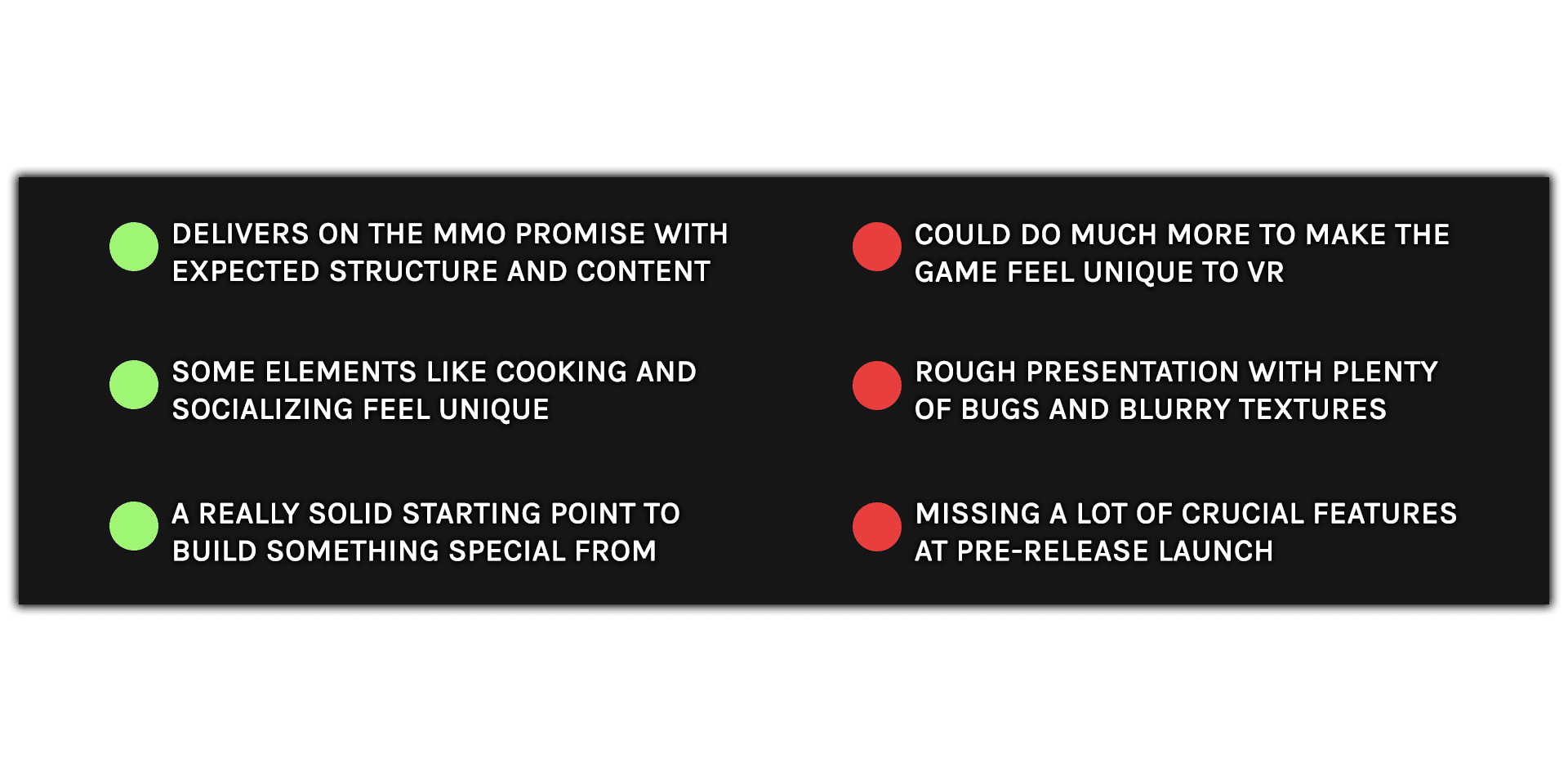Zenith is an inarguably rough but undeniably massive achievement for the VR industry, and already the best VR MMO. Read on for our Zenith review!
Note: Though we’re finally publishing our full review of Zenith today, take note that the game is still very much in early access (though it isn’t labeled as such on PSVR and Quest). We’ll be revisiting Zenith to update this review when necessary.
If you were to ask me what the most important element of Zenith is at launch, I’d tell you it’s the cooking. Not because of the expected stat buffs, but because of how well it works in VR. It’s a wonderfully cathartic process; flipping dough and timing temperatures requires attention and precision in a way a normal crafting menu simply couldn’t. It’s a small but significant indication of what VR can do to shake up one of gaming’s most important categories.
And that’s clearly what Zenith wants to do, not just routinely transplant a popular genre into headsets, but fully dissect, study and then re-piece the MMO to fit the medium much more suitably. It wants to take meaningful steps towards an experience like a Sword Art Online, not just name-drop such inspirations in hopes of a quick cash grab. At launch, it does at least some of that very well, but there’s a long way to go before Zenith really achieves those lofty ambitions.
Crucially, though, it’s already a step ahead of the competition. Make no mistake, Zenith is the first actual, proper native VR MMO that doesn’t exaggerate the extent of its online elements or structure. It’s already home to multiple expansive zones where players run wild, beating down enemies in search of experience points and loot, with limited time events pushing them into certain areas, quest lines that last for hours and a gear and progression system that rewards constant incremental improvement. That alone makes the game something of a landmark achievement for the industry, and multiple consistently full servers suggest it won’t be falling victim to the curse of empty VR lobbies anytime soon.
[vc_row][vc_column][vc_cta h2=””]Zenith Review – The Facts
What is it?: A VR MMO in which players hop online, meet up with friends and go questing to improve their characters.
Platforms: Quest 2, PSVR, PC VR
Release Date: January 27th
Price: $29.99/£24.99[/vc_cta][/vc_column][/vc_row][vc_row][vc_column][vc_column_text]
Most of this structure plays out as you’d expect. You pick between six classes (two main types with three interchangeable roles each and more on the way), whilst the vast majority of quests are your bog-standard items hunts, enemy encounters or scouting expeditions. Leveling up, meanwhile, increases your core stats and grants you new abilities known as Godstones, which in turn raise your chances of surviving in tougher zones.
This familiarity make Zenith a surprisingly undaunting undertaking. There’s a feather-light tutorial to kick things off and, while the game could certainly do a better job of explaining some elements, you’ll have mastered its core mechanics within your first hour of play.
What Zenith isn’t, though, is particularly original. If the game strives to build out something new for the MMO scene, then it’s certainly not within the core structure. The XP grind is alive and well here, and you can trace the design all the way back to the origins of the genre. If it reminded me of any MMO I’ve played it’d be the original version of Runescape, with its straightforward set of fetch quests easily seeing away hours with friends. While MMO devotees will no doubt enjoy how strictly it adheres to the rulebook, there’s definitely untapped potential to play more to VR’s strengths as the game evolves.
Combat, for example, makes attempts to diversify. Numbers still fly from foes as you deliver blows and a quest tracker keeps a tally of your objective progress toward the left of your vision, but developer Ramen VR tries to ensure you’re not just waggling your wrists away with your eyes glazed over the majority of the time.
Swordmasters wield two katanas, but there’s a small cooldown every time you land a blow, meaning you’ll do minimal damage if you furiously swipe back and forth. Mages, meanwhile, have two wrist-mounted gauntlets that fire projectiles operating on a similar cooldown (though laser sights do mean you never need to give too much thought to aim). Central to both roles are the Godstones, gesture-based abilities that can summon more powerful attacks, inflict status changes or aid you and your friends.
In my time as a damage-per-second class mage, I’ve summoned lighting, conjured fireballs that I can pluck from the air, shot gusts that knock enemies back or ignited walls of flame, and I’ve always had a great sense of just how quickly my character build is progressing. Godstones give the game much of its strategic depth and help emphasize teamwork between a range of classes, but the accurate gesture recognition system is what fuels the superpowered flow that combat achieves.
Appreciated as these tweaks to the formula are, more could be done to make Zenith’s battles more unique to VR, like sword combat that relies more heavily on your reflexes, with enemies telegraphing attacks to block or dodge in certain directions, or spells that require you to be much more precise to maximize damage. I’d happily tackle quests with fewer, more memorable enemy encounters that required me to react differently to a variety of attacks than I would champion the current rinse and repeat formula.
In fact, Zenith’s best elements pretty much all stem from VR-first design. On top of the fantastic cooking minigame, there’s unusually agile locomotion thanks to a gliding system borrowed from Population: One and the ability to climb pretty much any surface in the game. It’s liberating to be able to move around what is traditionally such a sluggish genre with such freedom, and Zenith’s best quests thus far also recognize this, getting you to clamber over floating platforms in search of levers before your stamina runs out.
They make for a madcap and often quite stressful dash unlike anything else you’ll find in the MMO scene, as do the races around zones in search of landmarks and statues. That said, they also make it incredibly easy to get around combat and essentially cheat your way to victory in some scenarios, which will no doubt need to be addressed in the future.
Then there’s easily the game’s central and best aspect, which is social. This is where Zenith rightly soars, with full cross-play between platforms (and cross-progression if you happen to own multiple copies), extensive friend, squad and guild systems as well as privacy options for those that want them. More importantly, though, there’s a sense of being together on an adventure in Zenith that you simply can’t get from other MMOs.
Part of that is that presence you get from VR, as fleeting as it may be with current headsets. A bigger aspect, though, is introducing body language and action into the experience in small but meaningful ways. Pointing other players in the direction of hidden chests, waving them over to areas of interest or urging friends to stop messing with you by throwing up your hands in protest – this all enhances the personality of the relationships you can build in the game. Sometimes I’d drop into a battle with random people and they’d high five me for the help, sometimes I knew I was interfering with someone else’s quest and they’d shoo me away. It’s a remarkably dynamic experience.
As Ramen maps out the months and years ahead, it’s these elements I want to see honed in on. Zenith does more than I expected to differentiate itself from flatscreen MMOs at launch, and that’s hugely encouraging. But it won’t, in its current state, bring around many MMO skeptics thanks to its focus on repetitive objective types and gameplay, not to mention the enormous amount of polish that still needs to be applied to it.
[vc_row][vc_column][vc_cta h2=””]Zenith Review – Comfort
Zenith supports both smooth locomotion and teleportation options, with a number of different settings to tweak to get the experience right for you. It’s not really a fast-paced game and you can very much acclimiatize to it as you go, though features like the gliding may cause a bit of a stir for those more sensitive to VR.[/vc_cta][/vc_column][/vc_row][vc_row][vc_column][vc_column_text]
Zenith’s presentation, in other words, isn’t rough around the edges so much as it is rough around the everything. From text spilling out of menu formatting to environmental textures clipping into each other, not to mention chests floating in mid-air and unsightly areas of blurred textures (many of which I suspect I wasn’t meant to be able to reach), it’s clear that many of the game’s core aspects are unfinished or just flat out missing.
Currently what you see with the game is pretty much what you get; a good number of large zones that you’ll clear through in a few hours before moving onto the next. Mission design doesn’t always make the most of these environments though and, once you’ve left an area, there’s little reason to return save for a particularly good XP farming spot or event.
The first area, Fractured Plains, includes one dungeon-like mine to delve into, but other environments don’t have any other sorts of offshoots. The framework is there for Ramen VR to simply add to these existing levels, as they’re all very well realized from the humble towns through to enormous fortresses and inviting beaches, and capitalize on the vertical traversal.
The same can be said for many more areas. Zenith needs more classes, new features like crafting, filling out empty city environments with more NPCs, a cohesive story (which I’m sure is in there somewhere I just can’t find it) and a whole host of aspects that are missing in action at this point in time. The entire game has an air of the unfinished about it which is to be expected in early access but also equally important not to forget given the game’s meteoric rise in popularity at launch.
Even with those features missing, though, the game has eaten up the hours for me. Most systems have extra offshoots to encourage experimentation for stat completists, be that upgrading Godstones by acquiring rare drops out in the field or enhancing the already-expansive amount of gear by breaking down your old loot, and you can even change your sub-class at an time and re-level them at twice the speed until you reach your current highest rank.
Those complexities aside, though, the core 30 – 40 hour campaign already warrants a look if you’re into MMOs and have friends to play with. Without the social element, Zenith’s combat and dog-eared look wouldn’t compare favorably to other single-player games (though solo grinding is entirely possible past a few bottlenecks). It’s a game for casually ticking off checklists as you glide alongside a friend, or jumping in to save a stranger from a battle a bit past their level, sharing secrets about hidden loot or racing each other to an objective marker. Simply put, it’s been a pure joy to get lost in its world with others, warts and all.
Zenith Review – Final Impressions
It would feel wrong to label Zenith as an essential VR experience right now, not necessarily because of its current flaws so much as how much ground it has to cover before you could definitively call it a complete product. There are many tens of hours of questing in its current form, but they’re largely identical objectives playing out in the game’s overworlds. A lack of unique dungeons and events — not to mention the small number of classes available at launch –holds the game back, and some of the many bugs you’ll find are a clear indicator of its early status. This really is just a starting point for the VR MMO.
But, crucially, it’s a solid foundation that already comfortably establishes Zenith as VR’s best stab at the genre yet. There’s hours to spend here exploring with friends and maxing out character stats, and even the current straightforward quest structure makes the game hard to put down. Most importantly you can get a glimpse of the aspects that are really going to make a difference in the long run, from the added expression you get from playing an MMO in VR to the way Ramen VR uses motion controls to deliver some more instant and enjoyable gameplay ideas than we’ve previously seen with the genre. If it can hone in on those elements and bring out the best of VR in a social setting, then this will be an unmissable VR experience.
We’re not at Sword Art Online just yet, then. Zenith has a ways to go before it even hopes to compare to some of its inspirations, but the journey’s already been more than worthwhile.
For more on how we arrived at this rating, read our review guidelines. What did you make of our Zenith review? Let us know in the comments below!

